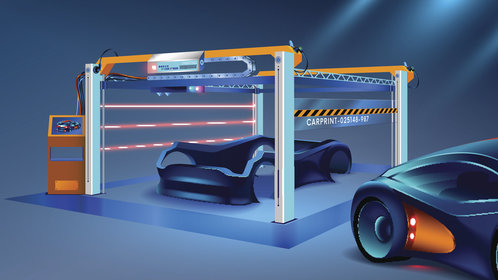
07/11/2017
3D printing, hi-tech revolution a delight for the automotive industry
Dino Collazzo
Additive Manufacturing techniques are a growing part of most industrial productions. The automotive world has grasped it’s economic potential and launched several experimental projects.
Choose the car you want and then print it in your own garage! In the future, perhaps, something like that might happen, but for now, we must acknowledge that additive manufacturing techniques are becoming an integral part of large-scale industrial production processes with the automotive industry among the quickest to understand it’s economic potential. In fact, car makers and large OEM producers have already started investing in 3D printing: a technology whose advantage is given by time-saving production processes for both vehicles and components as well as optimizing the use of raw materials.
The evolution of additive manufacturing techniques - from the design phase to production - will make this technology more affordable and efficient in the coming years. It’s a growing market that will inevitably attract large industrial players. A research conducted by International data corporation in January 2017 (an Ict and digital innovation market research firm) calculated that printers, materials, software and 3D printing related services accounted for a total value of $ 13.2 billion, in 2016. But the report shows more than that, forecasting a five-year compound growth rate (Cagr) of 22.3%, with a turnover of $ 28.9 billion by 2020. Most revenue is expected to come from the automotive industry.
Meanwhile, as the industry eagerly awaits to celebrate its union with AM technologies, several manufacturers - including Ferrari, Lamborghini, Volkswagen, Ford, Audi and Bmw, just to name a few - are testing its potential. For now experiments revolve around the production of single metal parts. The intent is to reduce the manufacturing costs of a wide range of components - chassis, engine parts, interior components – before embarking in large-scale productions. An ambitious target indeed, yet both automotive manufacturers and aftermarket OEM producers have decided to allocate some of their considerable resources in creating “ad hoc” divisions within their own companies as well as partnerships with 3D manufacturers. However, the run-up towards a widespread use of AM techniques isn’t limited to the automotive world and OEM component makers. 3D printing could soon affect other areas such as the spare parts sector with the workshop 4.0 age just around the corner. In the future, besides monitoring cars in remote, mechatronics and body shops could reduce repair times by “creating” spare parts "just in time". Meanwhile, the use of 3D printers has already taken a firm hold in the vintage car market. In this case, thanks to 3d scanners, parts of a vehicle’s body, that would otherwise be impossible to obtain, can be faithfully reproduced.
The fields of application of this technology, as well as business opportunities, are really huge. But a future widespread distribution and use of it cannot overlook the impact it will have on millions of employees. Especially on all those professions - mechanical engineers, industrialists, designers, welders and fitters - considered essential in creating and developing new vehicle models. A factor that must be carefully weighed by the business world as a whole (industrial giants and trade unions alike) along with Governments, who are called upon to identify an economic model and an industrial policy capable of getting the most out of this technological revolution while keeping the social fabric together.
The evolution of additive manufacturing techniques - from the design phase to production - will make this technology more affordable and efficient in the coming years. It’s a growing market that will inevitably attract large industrial players. A research conducted by International data corporation in January 2017 (an Ict and digital innovation market research firm) calculated that printers, materials, software and 3D printing related services accounted for a total value of $ 13.2 billion, in 2016. But the report shows more than that, forecasting a five-year compound growth rate (Cagr) of 22.3%, with a turnover of $ 28.9 billion by 2020. Most revenue is expected to come from the automotive industry.
Meanwhile, as the industry eagerly awaits to celebrate its union with AM technologies, several manufacturers - including Ferrari, Lamborghini, Volkswagen, Ford, Audi and Bmw, just to name a few - are testing its potential. For now experiments revolve around the production of single metal parts. The intent is to reduce the manufacturing costs of a wide range of components - chassis, engine parts, interior components – before embarking in large-scale productions. An ambitious target indeed, yet both automotive manufacturers and aftermarket OEM producers have decided to allocate some of their considerable resources in creating “ad hoc” divisions within their own companies as well as partnerships with 3D manufacturers. However, the run-up towards a widespread use of AM techniques isn’t limited to the automotive world and OEM component makers. 3D printing could soon affect other areas such as the spare parts sector with the workshop 4.0 age just around the corner. In the future, besides monitoring cars in remote, mechatronics and body shops could reduce repair times by “creating” spare parts "just in time". Meanwhile, the use of 3D printers has already taken a firm hold in the vintage car market. In this case, thanks to 3d scanners, parts of a vehicle’s body, that would otherwise be impossible to obtain, can be faithfully reproduced.
The fields of application of this technology, as well as business opportunities, are really huge. But a future widespread distribution and use of it cannot overlook the impact it will have on millions of employees. Especially on all those professions - mechanical engineers, industrialists, designers, welders and fitters - considered essential in creating and developing new vehicle models. A factor that must be carefully weighed by the business world as a whole (industrial giants and trade unions alike) along with Governments, who are called upon to identify an economic model and an industrial policy capable of getting the most out of this technological revolution while keeping the social fabric together.






